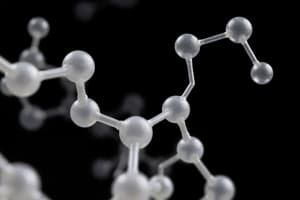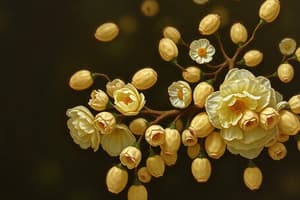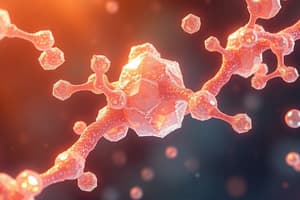Podcast
Questions and Answers
Which of the following classifications of monosaccharides indicates the presence of a ketone group?
Which of the following classifications of monosaccharides indicates the presence of a ketone group?
- Ketotetrose (correct)
- Aldotriose
- Aldopentose
- Aldohexose
What is the general formula for monosaccharides?
What is the general formula for monosaccharides?
- C_n(H_2O)_n+1
- C_nH_nO_n
- C_n(H_2O)_n-1
- C_n(H_2O)_n (correct)
How many carbon atoms are present in a pentose monosaccharide?
How many carbon atoms are present in a pentose monosaccharide?
- 4
- 5 (correct)
- 3
- 6
Which term refers to monosaccharides that can undergo hydrolysis to yield simpler sugars?
Which term refers to monosaccharides that can undergo hydrolysis to yield simpler sugars?
The suffix 'ose' in carbohydrate nomenclature primarily indicates what characteristic?
The suffix 'ose' in carbohydrate nomenclature primarily indicates what characteristic?
What is a characteristic of monosaccharides that determines their classification into D and L forms?
What is a characteristic of monosaccharides that determines their classification into D and L forms?
Which statement accurately describes the optical activity of a substance?
Which statement accurately describes the optical activity of a substance?
How many isomers can a substance containing three asymmetric carbon atoms potentially have?
How many isomers can a substance containing three asymmetric carbon atoms potentially have?
What distinguishes an anomer from other types of isomers?
What distinguishes an anomer from other types of isomers?
Which type of cyclic structure is a pyranose associated with?
Which type of cyclic structure is a pyranose associated with?
Which of the following are classified as aldoses?
Which of the following are classified as aldoses?
What is the main feature of all monosaccharides in terms of solubility?
What is the main feature of all monosaccharides in terms of solubility?
Which of the following compounds is a ketotriose?
Which of the following compounds is a ketotriose?
Which structure is characteristic of aldohexoses?
Which structure is characteristic of aldohexoses?
Which of the following is true about the optical activity of monosaccharides?
Which of the following is true about the optical activity of monosaccharides?
Which of the following is a property of all monosaccharides?
Which of the following is a property of all monosaccharides?
Which of these carbohydrates are classified as pentoses?
Which of these carbohydrates are classified as pentoses?
Which of the following carbohydrates is a ketohexose?
Which of the following carbohydrates is a ketohexose?
Flashcards
Monosaccharides
Monosaccharides
The simplest carbohydrate units, containing one sugar unit. They cannot be broken down into simpler forms by hydrolysis.
Disaccharides
Disaccharides
Carbohydrates composed of two monosaccharides joined together.
General formula of monosaccharides
General formula of monosaccharides
Cn(H2O)n
Aldoses
Aldoses
Signup and view all the flashcards
Polyhydric alcohol
Polyhydric alcohol
Signup and view all the flashcards
Ketose
Ketose
Signup and view all the flashcards
Triose
Triose
Signup and view all the flashcards
Glucose
Glucose
Signup and view all the flashcards
Fructose
Fructose
Signup and view all the flashcards
Optical Activity
Optical Activity
Signup and view all the flashcards
Solubility in Water
Solubility in Water
Signup and view all the flashcards
Asymmetric Carbon
Asymmetric Carbon
Signup and view all the flashcards
Optical Isomers
Optical Isomers
Signup and view all the flashcards
Anomers
Anomers
Signup and view all the flashcards
Anomeric Carbon
Anomeric Carbon
Signup and view all the flashcards
Study Notes
Carbohydrate Chemistry Overview
- Carbohydrates are aldehyde or ketone derivatives of polyhydric alcohols.
- They serve as a primary energy source (e.g., glucose).
- They form structural components in animal and plant cells (e.g., cellulose, chitin).
- Carbohydrates can combine with lipids or proteins (e.g., glycolipids, glycoproteins) and are part of cell membranes and intercellular substances.
Classification of Carbohydrates
- Monosaccharides: single sugar units (e.g., glucose, fructose, ribose).
- Disaccharides: two sugar units linked together (e.g., sucrose, lactose).
- Oligosaccharides: 3-10 sugar units.
- Polysaccharides: more than 10 sugar units (e.g., starch, glycogen, cellulose).
Monosaccharides: Structure and Nomenclature
- General formula: (CH₂O)ₙ
- Nomenclature: "-ose" suffix.
- Aldoses: contain an aldehyde group.
- Ketoses: contain a ketone group.
- Classification based on:
- Number of carbon atoms (triose, tetrose, pentose, hexose, heptoses).
- Functional group (aldose/ketose)
Monosaccharide Examples
- Provide specific examples of aldotriose, aldotetrose, aldopentoses, aldohexoses, ketotrioses, ketopentoses, and ketohexoses. The document includes structural formulas for specific examples
Physical Properties of Monosaccharides
- Soluble in water.
- Exhibit optical activity (ability to rotate polarized light).
- Optical activity depends on asymmetric carbon atoms.
Asymmetric Carbon Atoms
- A carbon atom bonded to four different groups.
- The presence of asymmetric carbon atoms leads to isomerism (e.g., D and L forms).
Isomerism
- Compounds with the same molecular formula but different spatial arrangements.
- Enantiomers (mirror images)
- D- and L- forms (common in biological systems).
Anomers
- Isomers differing in the configuration around the anomeric carbon atom.
- Anomeric carbon results from ring closure
- α and β anomers.
Pyranose and Furanose Forms
- Stable ring structures (pyranose - 6 membered ring, furanose - 5 membered ring) of monosaccharides.
- The majority of glucose exists in the pyranose form.
Studying That Suits You
Use AI to generate personalized quizzes and flashcards to suit your learning preferences.





